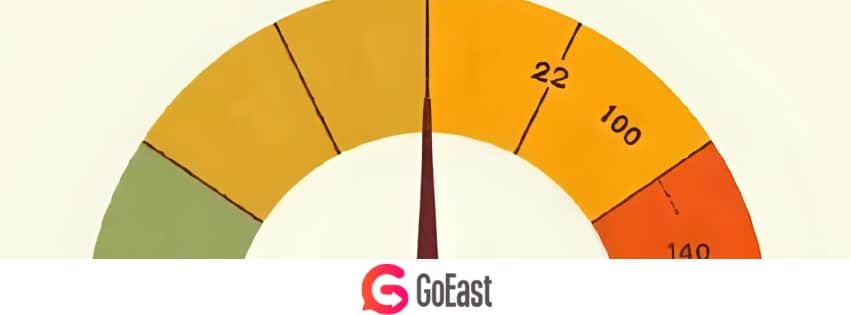Complete Celsius to Fahrenheit Guide
Ever found yourself staring at a weather app showing 25°C and wondering if you need a jacket? Or maybe you’re following a recipe that calls for 350°F but your oven only shows Celsius? You’re not alone. Converting between Celsius to Fahrenheit can feel tricky at first, but it’s actually pretty straightforward once you know the formula.
Whether you’re traveling abroad, cooking international recipes, or learning Chinese and need to understand temperature discussions, mastering this conversion will make your life easier. Let’s break it down step by step.
Updated July 2025
This comprehensive temperature conversion guide reflects the latest best practices for converting Celsius to Fahrenheit, including current measurement standards used in China and the United States. All formulas, examples, and cultural insights have been verified for accuracy as of July 2025.
Quick Answer Summary
– Formula: °F = (°C × 9/5) + 32
– Mental trick: Double Celsius, add 30 for quick estimates
– Key reference: 20°C = 68°F (room temperature)
– Chinese term: 摄氏度 (shèshìdù) for Celsius
– Cultural note: China uses Celsius exclusively; US uses Fahrenheit
The Basic Celsius to Fahrenheit Conversion Formula
The formula to convert Celsius to Fahrenheit is: °F = (°C × 9/5) + 32
Don’t let the math scare you off. Think of it as a simple three-step process:
-
- Multiply the Celsius temperature by 9
- Divide that result by 5
- Add 32 to get your Fahrenheit temperature
For example, if it’s 20°C outside:
- 20 × 9 = 180
- 180 ÷ 5 = 36
- 36 + 32 = 68°F
Pretty manageable, right?
Quick Mental Math Tricks
Sometimes you need a rough estimate without pulling out a calculator. Here are two shortcuts that work well:
The Double-and-Add-30 Method: Double the Celsius temperature and add 30. This gets you close enough for everyday use. So 20°C becomes (20 × 2) + 30 = 70°F. Not perfectly accurate (the real answer is 68°F), but close enough to know you’ll be comfortable in a light sweater.
Remember Key Reference Points: Memorize a few common temperatures. Water freezes at 0°C/32°F and boils at 100°C/212°F. Room temperature sits around 20-22°C (68-72°F). Your body temperature is about 37°C (98.6°F).
Quick Celsius to Fahrenheit Chart
| Celsius (°C) | Fahrenheit (°F) | What It Feels Like / Context |
|---|---|---|
| -10°C | 14°F | Very cold winter day, need heavy coat |
| -5°C | 23°F | Cold winter morning, ice likely |
| 0°C | 32°F | Water freezes, frost forms |
| 5°C | 41°F | Chilly day, need warm jacket |
| 10°C | 50°F | Cool spring day, light jacket needed |
| 15°C | 59°F | Mild weather, sweater comfortable |
| 20°C | 68°F | Comfortable room temperature |
| 25°C | 77°F | Perfect spring day, t-shirt weather |
| 30°C | 86°F | Hot summer day, shorts and tank top |
| 35°C | 95°F | Very hot, seek air conditioning |
| 37°C | 98.6°F | Normal human body temperature |
| 40°C | 104°F | Dangerous heat, high fever temperature |
| 45°C | 113°F | Extreme desert heat, life-threatening |
| 50°C | 122°F | Hot enough to cook an egg outside |
| 55°C | 131°F | Hot bath water, uncomfortable to touch |
| 60°C | 140°F | Very hot bath, can cause burns |
| 65°C | 149°F | Hot tea serving temperature |
| 70°C | 158°F | Hot coffee, pasteurization temperature |
| 75°C | 167°F | Ideal temperature for brewing green tea |
| 80°C | 176°F | Water for brewing black tea |
| 85°C | 185°F | Near-boiling, perfect for pour-over coffee |
| 90°C | 194°F | Almost boiling, bubbles start forming |
| 95°C | 203°F | Rolling boil starting, instant noodles ready |
| 100°C | 212°F | Water boils, steam forms |
Why Two Different Systems?
Here’s where things get interesting. Most of the world uses Celsius, but the United States sticks with Fahrenheit. It’s one of those cultural differences that can trip you up when traveling or communicating internationally.
Celsius makes scientific sense—it’s based on water’s freezing and boiling points at 0° and 100°. Fahrenheit, created earlier, uses a different reference system that results in smaller degree increments. Neither is “better,” they’re just different tools for measuring the same thing.
Fascinating Temperature Facts You’ve Never Heard
The “Fahrenheit Zero” mystery
Daniel Fahrenheit didn’t just pick random numbers. He set 0°F as the coldest temperature he could create in his lab using a mixture of ice, water, and salt. That’s why 0°F equals -17.8°C—it was literally the most extreme cold an 18th-century scientist could manufacture.
China’s temperature rebellion
Before 1959, China actually used a completely different system called the “Chinese temperature scale” where water froze at 0 degrees but boiled at 80 degrees. The switch to Celsius was part of Mao’s scientific modernization campaign.
Your body temperature changes by location
Here’s something medical schools barely mention—your “normal” 37°C (98.6°F) is actually wrong for most people. Recent studies show average human temperature has dropped to 36.6°C (97.9°F), and it varies by country due to lifestyle and genetics.
The upside-down country
Australia’s Bureau of Meteorology discovered that Australians instinctively think “30 degrees” means hot, even when hearing it in Fahrenheit contexts. Their brains have been rewired to associate the number 30 with warmth, regardless of the scale.
The cooking temperature conspiracy
Most Chinese restaurants in America actually cook at metric temperatures (180°C, 200°C) but staff convert to Fahrenheit when talking to customers. This is why Chinese-American food often tastes different than expected—the temperatures aren’t exact conversions.
Weather app psychology
Studies from 2023 show that people judge weather differently based on which scale they see first. Someone checking weather in Celsius is 23% more likely to choose appropriate clothing than someone seeing the same temperature in Fahrenheit first.
The fever detection gap
Chinese hospitals use 37.3°C as the fever threshold, while American hospitals use 100.4°F (38°C). This 0.7-degree difference means some low-grade fevers go undetected depending on which country you’re in.
Weird Temperature Zones Nobody Talks About
- The “Confusion Zone” (15-25°C / 59-77°F): This temperature range causes the most cultural misunderstandings. Americans think it’s “cool” while Chinese consider it “warm.” International business meetings often have thermostat conflicts in this zone.
- The “Goldilocks Gap” (19-21°C / 66-70°F): Psychological research shows this narrow 2-degree range is where humans make their worst temperature predictions. We consistently overestimate how hot or cold it will feel.
- The “Noodle Temperature” (85°C / 185°F): This is the optimal temperature for serving Chinese noodle soup—hot enough to be satisfying but cool enough to not burn your tongue. Most Chinese restaurants have mastered this temperature without thermometers.
The Future of Temperature Measurement
Digital temperature drift: Smartphone weather apps are slowly making people less accurate at estimating temperature. A 2024 study found that people who checked apps frequently were 31% worse at guessing outdoor temperature than those who relied on physical sensations.
The coming measurement war: China is pushing for a new international temperature standard based on quantum physics that would be more accurate than both Celsius and Fahrenheit. If adopted by 2030, it could make current temperature scales obsolete.
AI temperature bias: Current AI systems (including ChatGPT) show a slight bias toward Celsius when asked ambiguous temperature questions, even when communicating with American users. This happens because most training data comes from metric-using countries.
Temperature Talk in Chinese: A Language Learning Opportunity
If you’re learning Chinese, temperature conversations offer excellent practice for numbers, weather discussions, and daily life scenarios. Understanding measurements becomes even more important when you’re navigating life in a Chinese-speaking environment.
How to Say Temperature in Chinese
In Chinese, temperature is expressed using these key terms:
- 温度 (wēndù) – temperature
- 摄氏度 (shèshìdù) – degrees Celsius
- 华氏度 (huáshìdù) – degrees Fahrenheit
- 度 (dù) – degrees (the short form)
You’ll almost always hear Celsius in Chinese-speaking countries. When someone says “今天二十度” (jīntiān èrshí dù – “today is twenty degrees”), they mean 20°C, not 20°F.
Essential Temperature Vocabluary in Chinese
| Chinese | Pinyin | English | Usage Context |
|---|---|---|---|
| 温度 | wēndù | temperature | General term for temperature |
| 热 | rè | hot | Basic hot temperature |
| 冷 | lěng | cold | Basic cold temperature |
| 暖和 | nuǎnhuo | warm | Pleasantly warm |
| 凉快 | liángkuai | cool | Pleasantly cool |
| 炎热 | yánrè | scorching hot | Extremely hot weather |
| 酷热 | kùrè | sweltering | Unbearably hot |
| 严寒 | yánhán | bitter cold | Extremely cold weather |
| 冰冷 | bīnglěng | ice cold | As cold as ice |
| 温暖 | wēnnuǎn | warm (formal) | Gentle warmth |
| 凉爽 | liángshuǎng | refreshingly cool | Comfortably cool |
| 闷热 | mēnrè | muggy/stuffy hot | Hot and humid |
| 湿热 | shīrè | humid and hot | High humidity with heat |
| 干燥 | gānzào | dry | Low humidity |
| 潮湿 | cháoshī | humid/damp | High moisture content |
| 冰点 | bīngdiǎn | freezing point | 0°C/32°F |
| 沸点 | fèidiǎn | boiling point | 100°C/212°F |
| 摄氏度 | shèshìdù | Celsius | Temperature scale (°C) |
| 华氏度 | huáshìdù | Fahrenheit | Temperature scale (°F) |
| 度数 | dùshù | degrees | Temperature measurement unit |
| 零度 | língdù | zero degrees | 0° temperature |
| 零下 | língxià | below zero | Negative temperature |
| 零上 | língshàng | above zero | Positive temperature |
| 高温 | gāowēn | high temperature | Elevated heat levels |
| 低温 | dīwēn | low temperature | Reduced heat levels |
| 常温 | chángwēn | room temperature | Normal indoor temperature |
| 体温 | tǐwēn | body temperature | Human body heat |
| 发烧 | fāshāo | fever | Elevated body temperature |
| 发热 | fārè | generate heat/fever | Producing heat or fever |
| 退烧 | tuìshāo | break a fever | Reduce fever |
| 降温 | jiàngwēn | cool down | Lower temperature |
| 升温 | shēngwēn | heat up | Raise temperature |
| 保温 | bǎowēn | keep warm | Maintain temperature |
| 温度计 | wēndùjì | thermometer | Temperature measuring device |
| 气温 | qìwēn | air temperature | Atmospheric temperature |
| 水温 | shuǐwēn | water temperature | Heat level of water |
| 室温 | shìwēn | room temperature | Indoor temperature |
| 烫 | tàng | scalding hot | Dangerously hot to touch |
| 滚烫 | gǔntàng | boiling hot | Extremely hot, burning |
| 微温 | wēiwēn | lukewarm | Slightly warm |
| 温热 | wēnrè | warm to hot | Moderately warm |
| 发冷 | fālěng | feel cold/chilly | Experience coldness |
| 寒冷 | hánlěng | cold (formal) | Severe cold conditions |
| 寒气 | hánqì | cold air | Chilly atmosphere |
| 热气 | rèqì | hot air/steam | Warm vapor or atmosphere |
| 热浪 | rèlàng | heat wave | Period of excessive heat |
| 寒流 | hánliú | cold front | Mass of cold air |
| 暖流 | nuǎnliú | warm current | Mass of warm air or water |
| 冷却 | lěngquè | cool down/cooling | Process of becoming cold |
| 加热 | jiārè | heat up/heating | Process of adding heat |
| 恒温 | héngwēn | constant temperature | Steady heat level |
| 变温 | biànwēn | variable temperature | Changing heat levels |
| 温差 | wēnchā | temperature difference | Gap between temperatures |
| 最高温度 | zuìgāo wēndù | maximum temperature | Highest temperature reached |
| 最低温度 | zuìdī wēndù | minimum temperature | Lowest temperature reached |
| 平均温度 | píngjūn wēndù | average temperature | Mean temperature over time |
Asking about temperature:
- 今天多少度?(Jīntiān duōshǎo dù?) – What’s the temperature today?
- 外面冷不冷?(Wàimiàn lěng bù lěng?) – Is it cold outside?
Describing temperature:
- 很热 (hěn rè) – very hot
- 很冷 (hěn lěng) – very cold
- 温暖 (wēnnuǎn) – warm
- 凉爽 (liángshuǎng) – cool and comfortable
Specific temperature statements:
- 零下五度 (língxià wǔ dù) – minus five degrees (below zero)
- 三十八度 (sānshíbā dù) – thirty-eight degrees
- 发烧了,三十九度 (fāshāo le, sānshíjiǔ dù) – have a fever, thirty-nine degrees
Temperature Secrets Chinese Textbooks Don’t Teach
The “warm” character mystery: The Chinese character 暖 (nuǎn, warm) actually contains the radical for “sun” (日) in the left side. Ancient Chinese considered anything above 25°C as having “sun energy.”
The missing Fahrenheit words: Chinese has no traditional characters for Fahrenheit concepts. The term 华氏度 (huáshìdù) was literally invented in the 1920s by translating “Fahrenheit degrees” character by character. Before that, Chinese texts describing American temperatures had to use lengthy explanations.
Measurement Systems: China vs. USA
This temperature difference represents a bigger cultural shift Chinese learners encounter. China uses the metric system for everything, while the US mixes systems somewhat randomly.
In China, you’ll encounter:
- 公里 (gōnglǐ) – kilometers, not miles
- 公斤 (gōngjīn) – kilograms, not pounds
- 米 (mǐ) – meters, not feet
- 毫升 (háoshēng) – milliliters, not fluid ounces
- 摄氏度 (shèshìdù) – Celsius, not Fahrenheit
Learning these measurement terms isn’t just vocabulary practice—it’s cultural preparation. When your Chinese friend mentions driving 100 公里, that’s about 62 miles. When the weather forecast says 35度, you’ll want shorts and a cold drink, not a winter coat.
Practical Measurement Conversations
At the grocery store:
- 一公斤苹果多少钱?(Yī gōngjīn píngguǒ duōshǎo qián?) – How much for one kilogram of apples?
Talking about distance:
- 从这里到机场有多远?(Cóng zhèlǐ dào jīchǎng yǒu duō yuǎn?) – How far is it from here to the airport?
- 大概二十公里 (Dàgài èrshí gōnglǐ) – About twenty kilometers
Weather discussions:
- 明天最高温度二十八度 (Míngtiān zuìgāo wēndù èrshíbā dù) – Tomorrow’s high temperature will be twenty-eight degrees
Why This Matters for Language Learners
Understanding measurement systems goes beyond memorizing vocabulary. It helps you participate naturally in everyday conversations. When Chinese speakers discuss temperature, distance, or weight, they’re using a completely different mental framework than American English speakers.
This creates interesting teaching moments. Many Chinese learners studying in the US struggle initially with Fahrenheit temperatures and mile distances, just as American students in China need time to develop intuition for Celsius and kilometers.
Frequently Asked Questions
Q: What’s the easiest way to convert Celsius to Fahrenheit in my head?
A: Use the “double and add 30” method for quick estimates. For more precision, remember that every 5°C equals 9°F, so you can work with those ratios.
Q: Why doesn’t the US use Celsius like everyone else?
A: Historical timing, mostly. The US adopted Fahrenheit before the metric system became globally standard, and changing measurement systems across an entire country is complicated and expensive.
Q: How do I remember which system uses which numbers?
A: Think of Celsius as the “smaller numbers” system. Water freezes at 0°C (vs 32°F) and your body temperature is 37°C (vs 98.6°F). The Celsius numbers are always smaller for the same temperature.
Q: What’s the Chinese word for thermometer?
A: 温度计 (wēndùjì) – literally “temperature measuring device.”
Q: Do I need to convert temperatures when talking to Chinese speakers?
A: Not if you’re discussing temperatures in a Chinese context—they’ll naturally use Celsius. But if you’re explaining American weather or cooking temperatures, you might need to convert for clarity.
Making It Stick
Converting between temperature systems becomes second nature with practice. Start by checking weather apps that show both scales, or practice with cooking temperatures when trying international recipes.
For Chinese learners, temperature discussions offer a perfect combination of practical vocabulary and cultural understanding. You’re not just learning to say numbers—you’re learning to think about daily life the way native speakers do.
The next time someone mentions it’s 25°C outside, you’ll know immediately that it’s a beautiful 77°F day. And if you’re chatting in Chinese about the weather, you’ll sound natural discussing temperatures the way locals do. That’s the kind of cultural fluency that makes real conversations possible.





